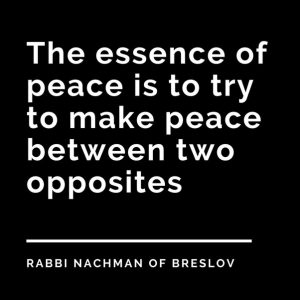
World peace seems like a far-fetched utopian concept when we look at today’s world.
To start with, what is peace? Is it simply the opposite of war? When we look into the word “peace” from the perspective of the wisdom of Kabbalah, we find a different definition to how the term is commonly conceived, and we also receive a method on how to achieve it.
Peace is commonly considered a state of no war. Humanity has created several peace treaties, ceasefires and armistices after tough conflicts, wars, and much suffering, and it is always a question of how long they will last until the next outburst.
The term “peace” in Hebrew (“Shalom”) equates to “completion” or “perfection” (“Shalem”). Is it enough that we have an absence of war in order to experience perfection? Of course not. If we look deeper into the word “peace,” we arrive at the common root of our nature, before we divided into different genders, races, species and diverse nations.
In today’s world, where we find ourselves among a rapidly rising global population of billions of people, we perceive ourselves as separate from each other, and often not at peace. Moreover, our lack of knowledge on how to reach peace is our main problem.
The wisdom of Kabbalah describes how nature develops us toward a state of total world peace. Approaching peace, however, requires recognizing that nature is an interconnected and interdependent system, and that we humans are the only disrupters of the sensitive balance in nature. More specifically, the human ego, which is a desire to enjoy at the expense of others, harms us, the world and nature.
Interestingly, as far back as 1930, in his article, “Peace in the World,” Kabbalist Yehuda Ashlag (Baal HaSulam) recognized the interconnected state of the world:
“Do not be surprised if I mix together the well-being of a particular collective with the well-being of the whole world, because indeed, we have already come to such a degree that the whole world is considered one collective and one society.”
How, then, do we achieve world peace?
Achieving world peace requires a long-term comprehensive social form of education that aims to raise us to discover a state of completion and perfection, and this is where the wisdom of Kabbalah, which describes nature’s causes, plan and functionality, can be of assistance. Kabbalah describes how we can impact self-transformation to change our egoistic nature to an altruistic one—a necessary change in order to reach a state of peace. As part of this transformation, we learn how to rise above our divisive drives that bring about separation between people and nations. Similar to a couple that makes up after an argument, uniting above division is what strengthens our connection.
Rabbi Nachman of Breslov explained, “The essence of peace is to try to make peace between two opposites” (Likutei Etzot, “Peace”). Also, it is written in Proverbs (10:12) that “Love will cover all transgressions.” Nature also contains a plethora of opposites working harmoniously as a single common system: light and darkness, heat and cold, sweet and bitter, and so on.
A process that leads to world peace thus depends on the development of an inclusion between opposites up to a point where a new feeling of the world emerges. Instead of feeling “them and us,” we come to feel a common whole in which we are all important parts.
Moreover, the wisdom of Kabbalah explains that we are all headed to a state of world peace, and Kabbalah is a method that lets us achieve this state faster, more enjoyable and with growing wisdom, knowledge and consciousness of the nature we all share.
Written/edited by students of Kabbalist Dr. Michael Laitman.
Featured in Quora